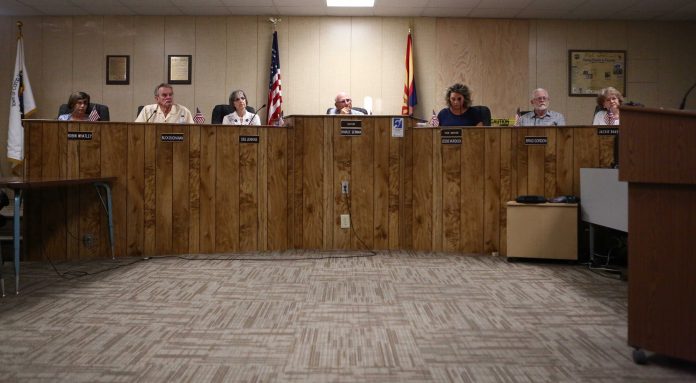At a meeting on March 21, the Camp Verde Town Council unanimously voted to increase wastewater fees. The planned increase of about $5 per month for most residents would pay for bonds used to expand the scope of the wastewater system, hoping to transition to less wastewater being drained into ponds and other natural water sources.
Six months later, with the new fee rates in place, some residents are upset, seeing their rates having jumped up far more than the expected amount.
Residents have written letters to local newspapers as well as turned up at Town Council meetings to express their displeasure at how rates have risen.
At a Sept. 19 meeting of the Camp Verde Town Council, government officials defended the rate increases, arguing that they were reasonable for most residents, and that the larger hikes for a few residents were better than the alternatives.
Under the recently implemented system, households are charged based on the number of water fixtures in the house, independent of the number of people living there or the amount used. According to Camp Verde Finance Director Mike Showers, the cost-per-fixture for single family residences is $2.52, which he argued would keep fees manageable for most residents, though it means high costs for a few large houses.
“There are only 86 homes that went over and above 12 percent, and that’s the top 8 percent of residents here in the valley,” Showers said. According to data Showers provided, the average rate in Camp Verde is $42.88 after the rate change, below wastewater rates for nearby municipalities like Clarkdale, Sedona and Prescott, though higher than Cottonwood and the Village of Oak Creek.
According to Showers, 61 percent of households in Camp Verde pay less than $50 monthly in wastewater fees, with 24 percent paying between $50 and $60, 7 percent paying more, and one household paying more than $90.
“We saw a pattern pretty quickly,” said Town Council member Dee Jenkins, who prepared a report on the wastewater increases for the rest of the council. “That was the elimination of the ceiling amount of previous rates. The cap of $50 went away because the wastewater accounts are billed now per fixture per amount. By doing that, it did affect about 100 users.”
Showers said eliminating the cap, while onerous to a few users who saw increases in their bills, is fairer than the previous system, pointing out that if households with many water fixtures are paying a lowered price because of the cap, it means that the cost they would bear is distributed among other users. Showers said it was more beneficial to most of Camp Verde’s residents, especially its poorer ones, to have high-fixture households pay for the cost of all their fixtures.
He added that changing the fee structure would cause its own problems.
“You’re going to be right back in the same situation again, because the rates will stay with the same coming in,” Showers said. “Who’s going to pay more, who’s going to pay less? With every concept that we talk about, someone wins [and] someone loses.”
Some council members brought up the idea of charging users purely based on the amount of usage, independent of the amount of fixtures in a household. However, both Showers and Town Manager Russ Martin said under the current setup, where the town does not own the water company, the town has no way of finding out this information and charging users accordingly, even if it wanted to.
The Camp Verde Town Council made no official actions in response to the report and discussion of wastewater fees.
Jon Hecht can be reached at 634-8551, or email jhecht@larsonnewspapers.com



